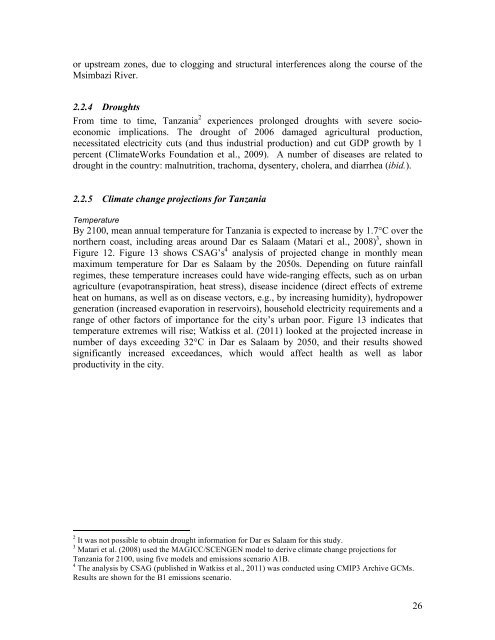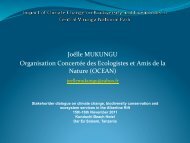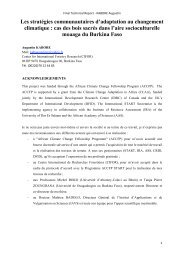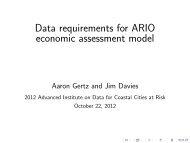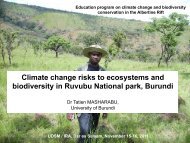Urban Poverty & Climate Change in Dar es Salaam, Tanzania:
Urban Poverty & Climate Change in Dar es Salaam, Tanzania:
Urban Poverty & Climate Change in Dar es Salaam, Tanzania:
You also want an ePaper? Increase the reach of your titles
YUMPU automatically turns print PDFs into web optimized ePapers that Google loves.
or upstream zon<strong>es</strong>, due to clogg<strong>in</strong>g and structural <strong>in</strong>terferenc<strong>es</strong> along the course of the<br />
Msimbazi River.<br />
2.2.4 Droughts<br />
From time to time, <strong>Tanzania</strong> 2 experienc<strong>es</strong> prolonged droughts with severe socioeconomic<br />
implications. The drought of 2006 damaged agricultural production,<br />
nec<strong>es</strong>sitated electricity cuts (and thus <strong>in</strong>dustrial production) and cut GDP growth by 1<br />
percent (<strong>Climate</strong>Works Foundation et al., 2009). A number of diseas<strong>es</strong> are related to<br />
drought <strong>in</strong> the country: malnutrition, trachoma, dysentery, cholera, and diarrhea (ibid.).<br />
2.2.5 <strong>Climate</strong> change projections for <strong>Tanzania</strong><br />
Temperature<br />
By 2100, mean annual temperature for <strong>Tanzania</strong> is expected to <strong>in</strong>crease by 1.7°C over the<br />
northern coast, <strong>in</strong>clud<strong>in</strong>g areas around <strong>Dar</strong> <strong>es</strong> <strong>Salaam</strong> (Matari et al., 2008) 3 , shown <strong>in</strong><br />
Figure 12. Figure 13 shows CSAG’s 4 analysis of projected change <strong>in</strong> monthly mean<br />
maximum temperature for <strong>Dar</strong> <strong>es</strong> <strong>Salaam</strong> by the 2050s. Depend<strong>in</strong>g on future ra<strong>in</strong>fall<br />
regim<strong>es</strong>, th<strong>es</strong>e temperature <strong>in</strong>creas<strong>es</strong> could have wide-rang<strong>in</strong>g effects, such as on urban<br />
agriculture (evapotranspiration, heat str<strong>es</strong>s), disease <strong>in</strong>cidence (direct effects of extreme<br />
heat on humans, as well as on disease vectors, e.g., by <strong>in</strong>creas<strong>in</strong>g humidity), hydropower<br />
generation (<strong>in</strong>creased evaporation <strong>in</strong> r<strong>es</strong>ervoirs), household electricity requirements and a<br />
range of other factors of importance for the city’s urban poor. Figure 13 <strong>in</strong>dicat<strong>es</strong> that<br />
temperature extrem<strong>es</strong> will rise; Watkiss et al. (2011) looked at the projected <strong>in</strong>crease <strong>in</strong><br />
number of days exceed<strong>in</strong>g 32°C <strong>in</strong> <strong>Dar</strong> <strong>es</strong> <strong>Salaam</strong> by 2050, and their r<strong>es</strong>ults showed<br />
significantly <strong>in</strong>creased exceedanc<strong>es</strong>, which would affect health as well as labor<br />
productivity <strong>in</strong> the city.<br />
2<br />
It was not possible to obta<strong>in</strong> drought <strong>in</strong>formation for <strong>Dar</strong> <strong>es</strong> <strong>Salaam</strong> for this study.<br />
3<br />
Matari et al. (2008) used the MAGICC/SCENGEN model to derive climate change projections for<br />
<strong>Tanzania</strong> for 2100, us<strong>in</strong>g five models and emissions scenario A1B.<br />
4<br />
The analysis by CSAG (published <strong>in</strong> Watkiss et al., 2011) was conducted us<strong>in</strong>g CMIP3 Archive GCMs.<br />
R<strong>es</strong>ults are shown for the B1 emissions scenario.<br />
26


